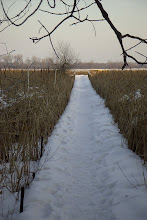Taking the train through the Rockies has long been on my list of things to do. Recently, I added that to the accomplishments pile.
The trip started with a bus ride from Madison, Wisconsin to Union Station in Chicago. I had planned to stash my rolling suitcase and computer bag in a locker for a couple of hours, then head over to Millenium Park to experience this new urban space firsthand.
Locker technology has changed considerably since I last put a couple of quarters into one. At Union Station the lockers are governed by a central control panel that requires you to scan a fingerprint twice to activate a locker. The cost? A lot more than a couple of quarters. When I realized that I would spend $8.00 for two hours of freedom from my bags, I decided to sacrifice convenience. Let's see - 40 or so lockers at $4.00 per hour. Okay, I'm in the wrong business. Add to that to do list - find out what company is behind these lockers.

Of course, it was rainy, windy and relatively cold in Chicago that day - rather miserable conditions for walking to Millenium Park. However, I was committed and would not be deterred. I had seen the scuptures, video art, gardens and other amenities of the park in articles and from 30 floors up in a nearby building. It was contextual to experience them on the ground, particularly when I walked to the Cloud Gate, looking for a little relief from the drizzle. Under Cloud Gate I met one of the few other souls in the park. In what is an all-too-common reminder of the fact that the economic downturn has a lot of personal faces, he asked me for spare change.
The trip started with a bus ride from Madison, Wisconsin to Union Station in Chicago. I had planned to stash my rolling suitcase and computer bag in a locker for a couple of hours, then head over to Millenium Park to experience this new urban space firsthand.
Locker technology has changed considerably since I last put a couple of quarters into one. At Union Station the lockers are governed by a central control panel that requires you to scan a fingerprint twice to activate a locker. The cost? A lot more than a couple of quarters. When I realized that I would spend $8.00 for two hours of freedom from my bags, I decided to sacrifice convenience. Let's see - 40 or so lockers at $4.00 per hour. Okay, I'm in the wrong business. Add to that to do list - find out what company is behind these lockers.

Of course, it was rainy, windy and relatively cold in Chicago that day - rather miserable conditions for walking to Millenium Park. However, I was committed and would not be deterred. I had seen the scuptures, video art, gardens and other amenities of the park in articles and from 30 floors up in a nearby building. It was contextual to experience them on the ground, particularly when I walked to the Cloud Gate, looking for a little relief from the drizzle. Under Cloud Gate I met one of the few other souls in the park. In what is an all-too-common reminder of the fact that the economic downturn has a lot of personal faces, he asked me for spare change.










